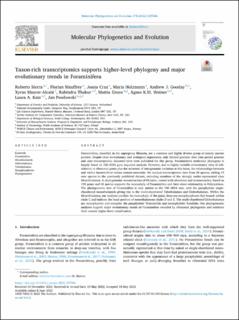| dc.contributor.author | Sierra, Roberto | |
| dc.contributor.author | Mauffrey, Florian | |
| dc.contributor.author | Cruz, Joana | |
| dc.contributor.author | Holzmann, Maria | |
| dc.contributor.author | Gooday, Andrew J. | |
| dc.contributor.author | Maurer-Alcalá, Xyrus | |
| dc.contributor.author | Thakur, Rabindra | |
| dc.contributor.author | Greco, Mattia | |
| dc.contributor.author | Weiner, Agnes | |
| dc.contributor.author | Katz, Laura A. | |
| dc.contributor.author | Pawlowski, Jan | |
| dc.date.accessioned | 2023-09-20T07:46:14Z | |
| dc.date.available | 2023-09-20T07:46:14Z | |
| dc.date.created | 2022-09-20T13:44:12Z | |
| dc.date.issued | 2022 | |
| dc.identifier.citation | Molecular Phylogenetics and Evolution. 2022, 174 . | en_US |
| dc.identifier.issn | 1055-7903 | |
| dc.identifier.uri | https://hdl.handle.net/11250/3090668 | |
| dc.description.abstract | Foraminifera, classified in the supergroup Rhizaria, are a common and highly diverse group of mainly marine protists. Despite their evolutionary and ecological importance, only limited genomic data (one partial genome and nine transcriptomic datasets) have been published for this group. Foraminiferal molecular phylogeny is largely based on 18S rRNA gene sequence analysis. However, due to highly variable evolutionary rates of substitution in ribosomal genes plus the existence of intragenomic variation at this locus, the relationships between and within foraminiferal classes remain uncertain. We analyze transcriptomic data from 28 species, adding 19 new species to the previously published dataset, including members of the strongly under-represented class Monothalamea. A phylogenomic reconstruction of Rhizaria, rooted with alveolates and stramenopiles, based on 199 genes and 68 species supports the monophyly of Foraminifera and their sister relationship to Polycystinea. The phylogenomic tree of Foraminifera is very similar to the 18S rRNA tree, with the paraphyletic single-chambered monothalamids giving rise to the multi-chambered Tubothalamea and Globothalamea. Within the Monothalamea, our analyses confirm the monophyly of the giant, deep-sea xenophyophores that branch within clade C and indicate the basal position of monothalamous clades D and E. The multi-chambered Globothalamea are monophyletic and comprise the paraphyletic Textulariida and monophyletic Rotaliida. Our phylogenomic analyses support major evolutionary trends of Foraminifera revealed by ribosomal phylogenies and reinforce their current higher-level classification. | en_US |
| dc.language.iso | eng | en_US |
| dc.rights | Navngivelse 4.0 Internasjonal | * |
| dc.rights.uri | http://creativecommons.org/licenses/by/4.0/deed.no | * |
| dc.subject | Foraminiferer | en_US |
| dc.subject | Foraminifera | en_US |
| dc.subject | Phylogenomics | en_US |
| dc.subject | Phylogenomics | en_US |
| dc.title | Taxon-rich transcriptomics supports higher-level phylogeny and major evolutionary trends in Foraminifera | en_US |
| dc.title.alternative | Taxon-rich transcriptomics supports higher-level phylogeny and major evolutionary trends in Foraminifera | en_US |
| dc.type | Peer reviewed | en_US |
| dc.type | Journal article | en_US |
| dc.rights.holder | © 2023 The Authors | en_US |
| dc.description.version | publishedVersion | en_US |
| cristin.ispublished | true | |
| cristin.fulltext | original | |
| cristin.qualitycode | 2 | |
| dc.identifier.doi | 10.1016/j.ympev.2022.107546 | |
| dc.identifier.cristin | 2053562 | |
| dc.source.journal | Molecular Phylogenetics and Evolution | en_US |
| dc.source.volume | 174 | en_US |
| dc.source.pagenumber | 6 | en_US |
| dc.relation.project | Swiss National Science Foundation: Grants 31003A_179125 and 316030_150817 (JP) | en_US |
| dc.subject.nsi | VDP::Matematikk og naturvitenskap: 400 | en_US |
| dc.subject.nsi | VDP::Mathematics and natural scienses: 400 | en_US |

